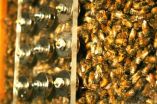(Press-News.org) Small details between "in vivo" and "in vitro" studies make for big differences in understanding diabetes and other secretory dysfunctions
Exocytosis, the fundamental process by which cells secrete hormones such as insulin and other useful biological substances, is regulated far differently in life than in laboratory tissue cultures and explanted organs, according to research presented today at the American Society of Cell Biology's 50th Annual Meeting in Philadelphia.
The unexpected findings that exocytosis regulation "in vivo" is not the same as the process long studied "in vitro" is a reminder of the gap between laboratory glassware experiments and the cell biology of living animals ⎯ and humans, said Roberto Weigert, Ph.D., of the National Institutes of Health (NIH), National Institute of Dental and Craniofacial Research (NIDCR).
During exocytosis, a cell internally packs up secretions and ferries them to the plasma membrane (PM) that demarcates the cell from its surroundings.
There, the packages, which are named secretory vesicles, fuse with the PM and then eject their contents. The process has been studied for decades in glassware experiments involving cultured cells and tissues.
Thanks to the optical imaging technology intravital microscopy. Weigert and colleagues were able to determine for the first time how exocytosis actually occurs in the salivary glands of a living mouse.
According to previous in vitro studies in the salivary glands, multiple secretory vesicles fuse with the PM, forming strings of vesicles in a process stimulated by two classes of chemical switches, muscarinic and beta-adrenergic receptors.
However, when the scientists examined the process in vivo, they saw the secretory vesicles fuse, not in strings, but one by one with the PM and only under stimulation from beta-adrenergic receptors.
Their additional in vivo studies revealed that the fusion step requires the assembly of a scaffold around the membrane of the vesicles.
This scaffold contains actin, a protein that forms filaments, and myosin II, a protein that binds to multiple actin filaments. When assembled, these molecules generate a contractile force that pushes the membranes and drives the fusion process to completion.
The molecular differences between in vivo and in vitro may seem minor but may have a large impact, said Weigert, because exocytosis is fundamental to understanding the basis of secretory dysfunctions such as diabetes in which insulin is transported in secretory vesicles.
### For more information:
ASCB contacts:
Cathy Yarbrough
sciencematter@yahoo.com
858-243-1814 (cell)
215-418-5306 (Dec. 11-15)
John Fleischman
jfleischman@ascb.org
513-929-4635 (before Dec. 11)
513-706-0212 (cell)
NIH contacts:
Roberto Weigert, Ph.D.
301-496-9969
weigertr@mail.nih.gov
Bob Kuska
301-594-7560
kuskar@nidcr.nih.gov
Weigert will present, "Role for the acto-myosin complex in the dynamics of regulated exocytosis revealed by intravital microscopy in live rodents," Monday, Dec. 13, 2010, 11:30 a.m. to 1:00 p.m., Exocytosis, Exhibit Halls A/B/C, Program 1225, Board B455.
Co-authors:
Masedunskas, M. Sramkova, L. Parente, P. Amornphimoltham. K. Uzzun-Sales, T.H. Bugge, R. Weigert, all at National Institute of Dental and Craniofacial Research, NIH.
Funding:
The Intramural Research Program of the NIH/NIDCR supported this research.
END
Researchers have provided the first thorough mechanistic account of how a genetic defect leads to malignant hypothermia (MH) and central core disease (CCD), rare genetic skeletal muscle disorders. The study appears in the January issue of the Journal of General Physiology (www.jgp.org).
Mutations in the type 1 ryanodine receptor (RYR1), the calcium release channel of the sarcoplasmic reticulum (SR) activated during skeletal muscle excitation-contraction (EC) coupling, give rise to CCD. One of the most common CCD-causing mutations is Ile4895Thr. Now, Robert Dirksen (University ...
ST. PAUL, Minn. – Many people with incurable brain tumors use alternative therapies, such as taking vitamins and homeopathy, in addition to their conventional treatments, according to a study published in the December 14, 2010, print issue of Neurology®, the medical journal of the American Academy of Neurology.
About 40 percent of brain tumor patients in the study used alternative therapies including homeopathic remedies, vitamin supplements and psychological therapy.
"The use of these alternative treatments may be largely overlooked and underestimated," said study ...
Folic acid can reduce birth defects including neural tube defects, congenital heart disease and oral clefts but some speculate high intakes of folic acid may be associated with adverse events such as colorectal cancer, states an article in CMAJ (Canadian Medical Association Journal) (pre-embargo link only) http://www.cmaj.ca/embargo/cmaj100568.pdf.
This study, conducted by researchers at Children's Hospital of Eastern Ontario Research Institute and The Hospital for Sick Children, is the first of its kind in more than three decades, to examine the folate status of Canadians ...
Disease-management programs, which may include patient education, psychological intervention, dietary education, self-monitoring and telemedicine, can improve diabetes care, states an article in CMAJ (Canadian Medical Association Journal) (pre-embargo link only) http://www.cmaj.ca/embargo/cmaj091786.pdf.
The study, by French researchers, included 41 randomized controlled trials published between 1990 and 2009 with a total of 7013 patients.
The findings showed that disease-management programs are more effective than usual care in reducing glycated hemoglobin levels ...
VIDEO:
This movie spotlights one waggle dance by a forager that had been sleep-deprived the
previous night. The average dance angle of this dance is superimposed over the dancer and variance around...
Click here for more information.
AUSTIN, Texas—In the busy world of a honey bee hive, worker bees need their rest in order to best communicate the location of food to their hive mates, research from The University of Texas at Austin shows.
"When deprived of sleep, humans ...
SAN ANTONIO, Texas, U.S.A. (Dec. 13, 2010) — Scientists at the UT Health Science Center San Antonio restored learning and memory in an Alzheimer's disease mouse model by increasing a protein called CBP. Salvatore Oddo, Ph.D., of the university's Department of Physiology and Barshop Institute for Longevity and Aging Studies, said this is the first proof that boosting CBP, which triggers the production of other proteins essential to creating memories, can reverse Alzheimer's effects.
The finding, reported this week in Proceedings of the National Academy of Sciences, provides ...
Boston, Mass. – It's widely recognized that fragmentation of medical information is a problem in health care, but the extent of the problem and how many patients may be at risk haven't been well quantified. In a new retrospective study, researchers at Children's Hospital Boston looked at adult acute care in Massachusetts and found that of 3.6 million adults visiting an acute care site during a five-year period, almost a third sought care at two or more different hospitals. These patients accounted for more than half of all acute care visits in the state, as well as more ...
The number of people with asthma has increased sharply over the past few decades. It has been suggested that this is a result of decreased childhood exposure to microorganisms. A team of researchers — led by Dale Umetsu, at Harvard Medical School, Boston; Michio Shimamura, at the University of Tsukuba, Japan; and Petr Illarionov, at the University of Birmingham, United Kingdom — has now provided concrete evidence in mice to support this idea and identified an underlying mechanism to explain this protection, which the team hope could be exploited to develop ways to prevent ...
Chronic myeloid leukemia (CML) was transformed from a fatal disease to a chronic condition by the development of a drug known as imatinib, which targets the protein that drives this disease (BCR-ABL). However, imatinib does not cure patients, they must take the drug lifelong, as disease recurs if they stop taking it. This is because imatinib does not kill all the CML cells; some, which are known as CML stem cells, persist. A key to therapeutically targeting CML stem cells is knowing whether they rely on BCR-ABL to persist. Answers to this will determine whether more effective ...
EDITOR'S PICK: A benefit of 'flu: protection from asthma?
The number of people with asthma has increased sharply over the past few decades. It has been suggested that this is a result of decreased childhood exposure to microorganisms. A team of researchers — led by Dale Umetsu, at Harvard Medical School, Boston; Michio Shimamura, at the University of Tsukuba, Japan; and Petr Illarionov, at the University of Birmingham, United Kingdom — has now provided concrete evidence in mice to support this idea and identified an underlying mechanism to explain this protection, which ...

